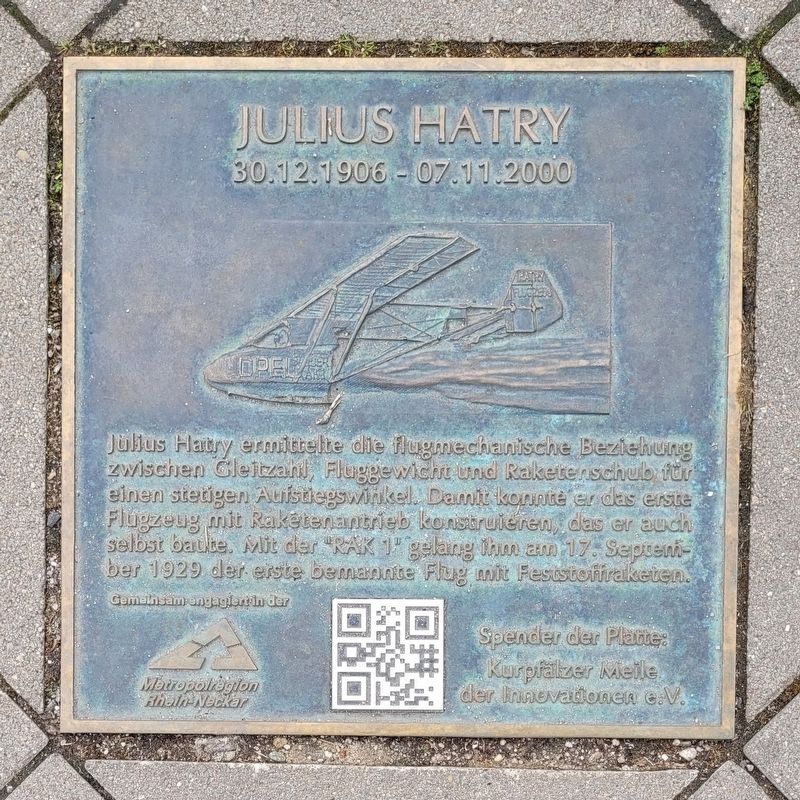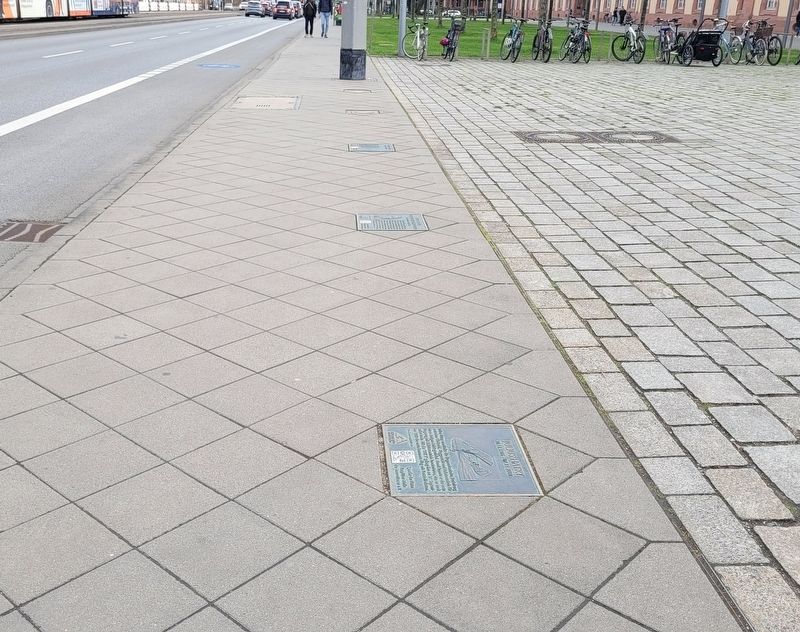Quadrate in Mannheim, Baden-Württemberg, Germany — Central Europe
Julius Hatry
30.12.1906 - 07.11.2000
Julius Hatry ermittelte die flugmechanische Beziehung zwischen Gleitzahl, Fluggewicht und Raketenschub für einen stetigen Aufstiegswinkel. Damit konnte er das erste Flugzeug mit Raketenantrieb konstruieren, das er auch selbst baute, Mit der “RAK 1" gelang ihm am 17. September 1929 der erste bemannte Flug mit Feststoffraketen.
Julius Hatry determined the flight mechanics relationship between glide speed, flight weight and rocket thrust for a constant angle of ascent. This enabled him to design the first aircraft with rocket propulsion, which he also built himself. With the “RAK 1” he achieved the first manned flight with solid fuel rockets on September 17, 1929.
Erected 2021 by Metropolregion Rhein-Neckar and Kurpfälzer Meile der Innovationen e.V.
Topics. This historical marker is listed in this topic list: Air & Space. A significant historical date for this entry is September 17, 1929.
Location. 49° 29.042′ N, 8° 27.818′ E. Marker is in Mannheim, Baden-Württemberg. It is in Quadrate. Marker is on Bismarckstraße just east of Kurpfalzstraße, on the right when traveling east. The marker is located along the sidewalk in front of the University of Mannheim. Touch for map. Marker is at or near this postal address: B37 20-40, Mannheim BW 68161, Germany. Touch for directions.
Other nearby markers. At least 8 other markers are within walking distance of this marker. Prof. Dr.-Ing. Karl Friedrich Marguerre (here, next to this marker); Hugo Stotz (here, next to this marker); Rudolf Fuchs (here, next to this marker); Bulldog (a few steps from this marker); Nobelpreis für Medizin / Nobel Prize for Medicine (a few steps from this marker); Nobelpreis Chemie / Nobel Prize in Chemistry (a few steps from this marker); Pepperl+Fuchs (a few steps from this marker); Ludwig Roebel (a few steps from this marker). Touch for a list and map of all markers in Mannheim.
More about this marker. The bronze plaque is one of 42 plaques set up along the “Electoral Palatinate Mile of Innovations” in front of Mannheim Palace.
Also see . . . Julius Hatry. Wikipedia
Hatry was thrilled about the prospects of rocket flight. Immediately, in April 1929, he rented a workshop in Gersfeld (Rhön) and began to design and build his machine himself. He worked obsessively, faced with competition from the entire aviation industry. It was not a converted glider (as the "Lippisch Ente"), but a special design and construction according to the building regulations of the time for powered airplanes, which were much stricter than for gliders. The aircraft was intended exclusively for propulsion using solid-fuel rockets and for launch using a solid-rocket catapult, making it the first rocket aircraft in the world. It was at this time that Fritz von Opel found out about Hatry's work. Fritz von Opel, son of Wilhelm von Opel, was a co-owner of the car company and headed the advanced engineering and vehicle testing department and was also responsible for the Public Relations of the Opel company. Von Opel was already well-known as highly successful in any type of motors sports. Within Opel RAK, he and Max Valier, based on their successful rocket-powered land vehicles, wanted to build a rocket plane - leading to the Opel RAK experiments by Stamer and Lippisch at Wasserkuppe. Von Opel piloted himself the spectacular speed record drive of the RAK2 at the AVUS racetrack in Berlin, before a huge crowd and world media in 1928. The RAK2 car, as its predecessor the RAK1 rocket car, was built in Rüsselsheim on the company premises, equipped with rockets by Friedrich Sander (1885-1938).(Submitted on February 23, 2024, by James Hulse of Medina, Texas.)
Credits. This page was last revised on February 23, 2024. It was originally submitted on February 23, 2024, by James Hulse of Medina, Texas. This page has been viewed 44 times since then. Photos: 1, 2. submitted on February 23, 2024, by James Hulse of Medina, Texas.

